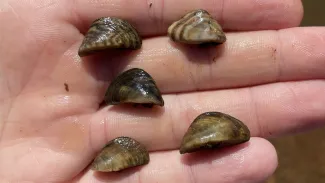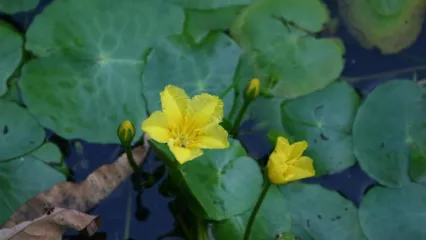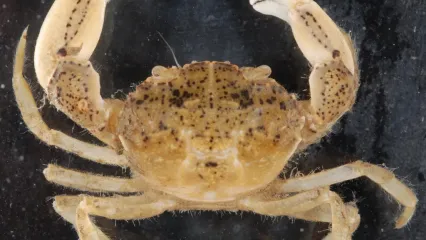
Description
Due to their high reproductive rate and the limited number of natural predators (diving ducks and freshwater drum), zebra mussels can significantly populate a body of water in two or three years. They can cluster together with hundreds of thousands per square meter. As a general practice, washing and scrubbing your boat and its equipment, and allowing it to completely dry between uses will prevent the spread of zebra mussels and plants.
The primary way zebra mussels spread is on trailered boats. Whether your boat has been in infested waters for one day - or one year - it could be carrying zebra mussels. A female can release up to one million eggs each season so transporting just one zebra mussel can spell trouble for waters and your boat!
Size
- Triangular (D-shaped) and brownish shell.
- Zebra like patterns -- alternating dark and light stripes.
- Can grow up to 2 inches long (5 cm) but is ordinarily about as big as a fingernail.
- Usually attached in clusters to hard surfaces like water pipes and boats.
- They can attach to plants, crayfish, and any stable structure.
Habitat
Zebra mussels are native to the Caspian Sea region of Asia. They are believed to have been transported to the Great Lakes via ballast water from a transoceanic vessel. Since their introduction to the Great Lakes in 1986, zebra mussels have quickly spread and are now found in at least 25 states and two Canadian provinces.
Zebra mussels are considered one of the most troublesome invasive species in North America. ODWC’s Aquatic Nuisance Species (ANS) program has confirmed invasive zebra mussels in many water bodies throughout Oklahoma.
These locations include:
Arcadia, Ardmore City, Canton, Carl Blackwell, Chimney Rock, Ellsworth, Eufaula, Foss, Ft. Gibson, Grand, Hefner, Hudson, Kaw, Keystone, McMurty, Murry, Overholser, Oologah, Pawnee City, Ponca City, Robert S. Kerr, Shawnee Twin Lakes, Skiatook, Sooner, Texoma, Tom Steed Reservoir, as well as in the lower Canadian, Cimarron, Arkansas, Verdigris, Washita and North Canadian rivers.
The zebra mussel’s reproductive and living habits have raised concerns that they may affect the aquatic environment. They are filter-feeders, which can result in less food available for other native species of mussels and fish. As well as alter water chemistry, in many cases, they make the water clearer, which has resulted in severe blooms of filamentous algae. Zebra mussels have sharp shells, which can cut the feet of people enjoying the area.
Zebra mussels may also affect man-made facilities by clogging water intake pipes and disrupting withdrawal operations. The mussels attach themselves to and grow within, water intakes of both inboard and outboard motors. Zebra mussels also clog power plants and public water intakes and pipes, which can cost taxpayers millions.
How To Observe
Zap the Zebra
Although some treatments have proven effective for spot control, eliminating zebra mussels once they are established is not likely.
Before leaving infested waters:
- Look for adult zebra mussels.
- Remove all visible mussels.
- Feel your boat’s hull for rough or gritty surfaces.
- Wipe all gritty areas with disposable cloth, and throw cloth in trash.
- Drain all water (bilge water, live well, and bait buckets).
If you think you have discovered any invasive species contact us at (918) 200-4815 or report online.


